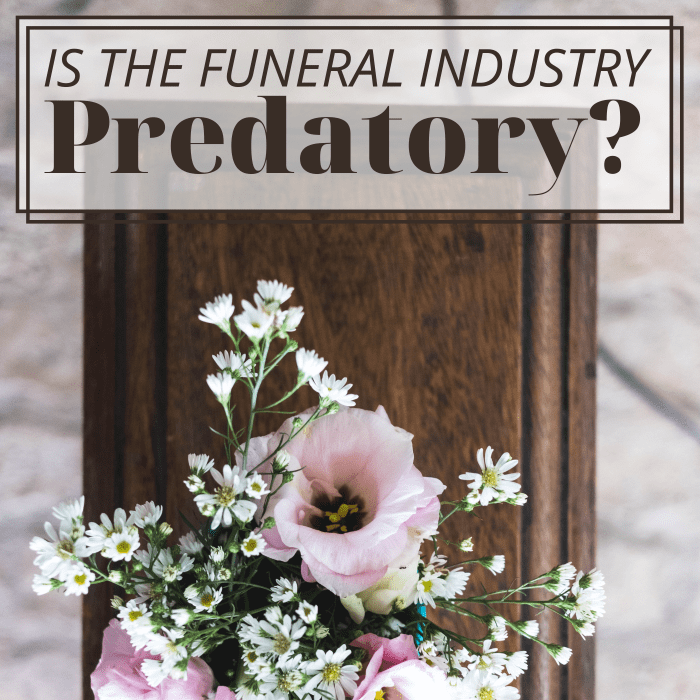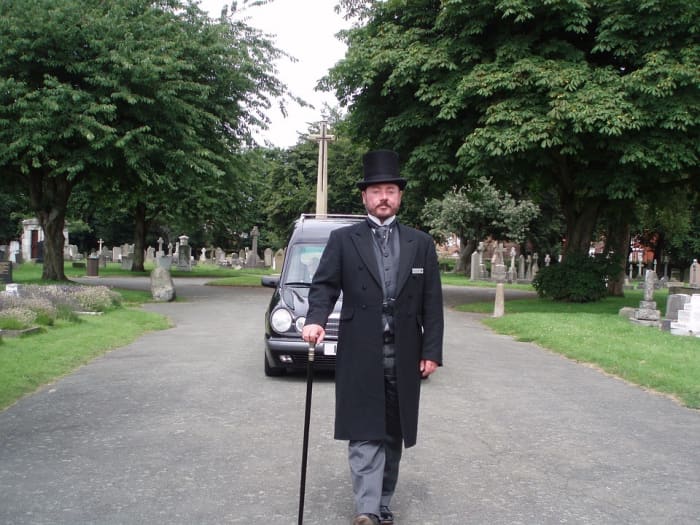What to Say When Someone Is Attending a Funeral
I've spent half a century (yikes) writing for radio and print—mostly print. I hope to be still tapping the keys as I take my last breath.

The funeral industry interacts with members of the public during some of their most vulnerable moments.
Mayron Oliveira via Unsplash; Canva
Jessica Mitford's 1963 book The American Way of Death blew the lid off how the dead were handled. She exposed the massive overcharging of bereaved relatives at their most emotionally vulnerable and railed against the practice of gussying up the deceased so loved ones could pretend that death had not actually occurred.
There's scant evidence that the industry has changed much since the release of Mitford's book.
The American Way of Death
When Jessica Mitford delivered her manuscript to her publisher, they blanched. They decided they couldn't publish it because it was far too gruesome. But Ms. Mitford's text was neither sensationalized nor exaggerated; it was a factual description of an industry that bilked its customers with suitable black-clad solemnity. Yes, the book did contain a certain amount of gallows humour.
Mitford focussed considerable attention on the practice of embalming, pointing out that it is not required by religious custom, nor law, nor any considerations of sanitation. It is done routinely for no other reason than that it generates income for the funeral service.
The corpse is drained of all blood, which is replaced in a cosmetic restoration process conducted by the embalmer. Mitford tells us that "He is supplied by an advanced chemical industry with a bewildering array of fluids, sprays, pastes, oils, powders, creams, to fix or soften tissue, shrink or distend it as needed, dry it here, restore the moisture there."
"The deceased 'is whisked off to a funeral parlour and is in short order sprayed, sliced, pierced, pickled, trussed, trimmed, creamed, waxed, painted, rouged, and neatly dressed—transformed from a common corpse into a Beautiful Memory Picture.'"
— Jessica Mitford, "The American Way of Death"
Now, it's time for an instrument called a trocar. This is used to remove all the squishy stuff in the abdominal and chest cavities, which is then replaced by formaldehyde. Each year, 800,000 gallons of formaldehyde, a known carcinogen, go into the ground inside buried bodies.
Then, the cadaver is "casketed" and wheeled into the funeral chapel for viewing. They are made to look as if they are in perfect health and are simply sleeping on a bed of satin. It is a stage-managed attempt to deny mortality.
So, is embalming still done today? It certainly is, although some of the more toxic chemicals have been replaced.

Is the high cost of funerals necessary?
Ian on Flickr
The High Price of Funerals
The American funeral industry doesn't like to use the word "coffin," so "casket" has become the standard terminology for the funerary box, and the body in it is not dead but "resting."
In some jurisdictions, it is perfectly legal to bury a body without a casket, while in others, a casket is required. However, the burial container doesn't have to be a French-polished mahogany job costing $5,000. Far less expensive and more environmentally friendly options are available, such as canvas, cardboard, or the traditional pine box, but the funeral industry doesn't want customers to know about them, as they fetch far less profit.
In Ontario, Canada, the provincial Auditor General recently sent out teams of mystery shoppers to "100 licensed funeral homes, transfer services, cemeteries, and crematoriums." The investigators found that in half the places visited, they "experienced sales pressure and/or were given misleading information. Also, when they inquired about the cost of a basic cremation at 70 operators, the quotes ranged from $512 in Windsor to a high of $8,000 in Toronto."
The Canadian Broadcasting Corporation is one organization that has exposed funeral home upselling practices. Using hidden cameras, it has caught funeral home staff telling bereaved relatives that they can't use a cheap coffin and that they have to pay for embalming, neither of which is true.
Read More From Toughnickel
Perfect Goodbyes is an organization that provides information about the cost of funerals in the United States. Depending on location, the group says funerals involving burial cost anywhere from $1,957 (in Billings, Montana) to $11,805 (in Boston, Massachusetts). Cremations generally come in at half that price.
In the United Kingdom, "people typically spend between £3,000 and £5,000 ($4,131 and $6,885) on a funeral" (The Guardian). Prices have risen by three times the rate of inflation over the past decade, prompting the government's Competition and Markets Authority to investigate the industry.
It's the same story as in North America—funeral companies are price-gouging people who are at an emotional low point in their lives that makes them vulnerable. Similar complaints have been lodged against the funeral industry in Australia.

Do funerals have an impact on the environment?
Public domain
The Environmental Cost of Funerals
While the dollar cost of funerals to families is well known, the environmental cost to the community is less recognized. The environmental group Talk Death has done some calculations. Within the one million acres of land in the United States covered by cemeteries there are:
- "115 million tons of casket steel, enough to build over 2,000 Empire State buildings;
- 2.3 billion tons of concrete from burial walls . . . [enough] to pave a sidewalk to the Moon 28 times; and,
- Casket wood equivalent to four million acres of forest . . . all that wood could build 4.6 million single-family homes."
Okay, then let's go with cremation. There are, as it turns out, some rather startling numbers associated with this process as well:
- "North America uses enough fossil fuel for cremation to drive you halfway to the Sun every year." (Talk Death)
- Cremation of one body "releases the same amount of nitric oxide and nitrogen dioxide as a car driving 2,280 miles." (Value Walk)
- Pollutants from cremation "can include polychlorinated dibenzo-p-dioxins (PCDDs) and dibenzofurans (PCDFs) and polycyclic aromatic hydrocarbons (PAH) amongst others; Heavy metals: Mercury (Hg) arising from volatilization of Hg in dental amalgam in fillings and a small quantity of various metals in tissues of the individual, or personal memorial items included in the casket." (National Collaboration Centre for Environmental Health in Canada).
Green Burials
Reducing the environmental impact of end-of-life treatments is becoming more popular. In 2006, there was only one green burial provider in North America. Today, there are more than 300.
The Green Burial Council tells us that "Natural burial grounds, cemeteries, and preserves all seek to bury without impediment. That means no embalming, no liners or vaults, and using biodegradable containers, whether caskets, shrouds or nothing at all."
And yes, the body is recycled through the natural processes of decomposition and consumption by insects and worms. This may be a bit troublesome for the squeamish, but the Green Burial Council reminds us of the words of naturalist and environmentalist John Muir: "Let children walk with Nature, let them see the beautiful blendings and communions of death and life . . . and they will learn that death is stingless indeed, and as beautiful as life."
Bonus Factoids
- Caskets, on average, represent about one-third of the cost of a funeral.
- In the United States, 86 percent of funeral homes are owned and operated as independent family businesses.
- The largest funeral home chain in America is Service Corporation International, which has come in for a lot of criticism. A study by the Funeral Consumer Alliance in 2017 uncovered "anti-consumer practices including relatively high prices that it fails to disclose adequately, aggressive sales that push customers to upgrade products purchased, and sloppy service that have led to court settlements as large as $80 million."
The Final Wishes of Folkie Lee Hayes
Sources
- "Embalming Mr. Jones." Jessica Mitford, The American Way of Death, 1963
- "Environmental Impact of Funerals Infographic." talkdeath.com, March 24, 2014.
- "More Consumer Protection Needed in Ontario's Bereavement Industry: Auditor General." Office of the Auditor General of Ontario, December 7, 2020.
- "What Is the Average Cost of a Funeral? (2021)?" perfectgoodbyes.com, undated.
- "UK Funerals Industry under Investigation for High Prices." Julia Kollewe, The Guardian, November 29, 2018.
- "Pollution Secrets of Crematoriums: A Hidden Public Health Issue." valuewalk.com, February 17, 2021.
- "Crematoria Emissions and Air Quality Impacts." Juliette O'Keeffe, National Collaboration Centre for Environmental Health, March 24, 2020.
- The Green Burial Council.
- "Death with Dignity? A Report on SCI/Dignity Memorial High Prices and Refusal to Disclose These Prices." Joshua Slocum, Funeral Consumer Alliance, March 2017.
This content is accurate and true to the best of the author's knowledge and is not meant to substitute for formal and individualized advice from a qualified professional.
© 2021 Rupert Taylor
What to Say When Someone Is Attending a Funeral
Source: https://toughnickel.com/industries/Investigating-the-Funeral-Industry